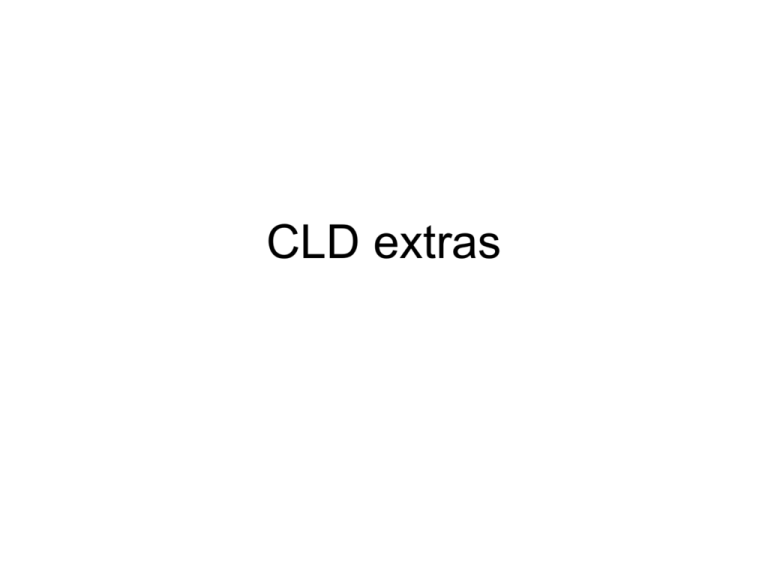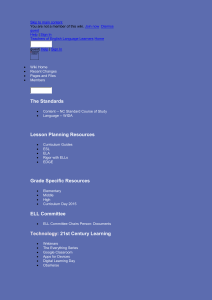CLD extras
advertisement

CLD extras • English as a Second Language (ESL) teachers must have special preparation to teach English to non-native speakers; being a fluent speaker or an effective teacher of English to native speakers is not enough. Just as teaching mathematics or French requires special knowledge and skills, teaching English as a Second Language does also (Kreidler, 1986) Urban Institute Report (2005) • ELL students increased from 2.8 million in 1993 to over 4 million in 2003 • It is estimated that 10% of elementary schools have LEP populations of 25% or more and 69% of the total US LEP population • These same elementary schools average 47% of their school enrollment as LEP • Only about 43% of all elementary schools have no LEP students More from the Urban Institute Report (2005) • Schools with high concentrations of LEP students exist in large urban areas. These schools also have large concentrations of African American students. • Schools with low concentrations of LEP exist in rural and suburban areas. These schools have high concentrations of White Americans. Urban Institute Report (2005) continues • Highly concentrated LEP schools are more likely to adapt and accommodate instruction for ELL. • More standardized procedures are used for identification in high-LEP schools. • High LEP schools are more likely to have parent outreach and support activities. • High LEP schools have more difficulty hiring qualified teachers and credentialed principals than other schools. • More diverse and less experienced teaching population in high-LEP schools Overview of TESOL courses • • • • • • • • • Early Childhood Development Toddler through Age 5 Elementary Age Development Ages 6-9 Junior High Age Development Ages 10-13 High School Age Development Ages 14-17 II. Overview of Second Language Acquisition and Teaching Levels III. Learning Styles for Different Intelligence Types IV. Discipline in the Classroom V. Teaching Approaches 1. Rassias Method 2. Total Physical Response 3. Content-Centered Language Learning 4. Lexical Approach 5. Whole-Language Approach 6. Communicative Approach • VI. Lesson Planning • 1. Circle Time/Transitions 2. Site Words 3. Music in the Classroom 4. Fun with Science 5. Game Playing 6. Role-Playing 7. Artworks 8. Drop Everything and Read 9. Debate Teams • VII. Review • Rassias Method: Fundamentals, Why it Works, Classroom Functions • Other Models • Online Time with Instructor • Teacher Placement Idyllwild Arts ESL academy distinctions ESL Department Curriculum Placement of ESL students is based on the SLEP Test and a personal interview with the ESL faculty. Faculty monitor placement and make appropriate changes as students progress. All changes are designed to enable international students to mainstream as soon as soon as possible and to score well on the TOEFL Test before they graduate. • Beginning ESL Beginning ESL students have four or five hours of classroom instruction each day focusing on basic reading, literature, writing, listening and speaking skills as well as essential grammar, vocabulary and study skills. A one semester course in math language proficiency is included. • High-Beginning ESL High-Beginning level ESL students have a proficiency in basic English skills. A student at this level is scheduled for four hours of ESL each day and might also attend a math class appropriate to his/her mathematical ability. Instruction focuses on the same skills as Beginning ESL but is given at a faster pace and in more depth. Also included is a formal study of world history and geography. • Intermediate ESL Intermediate ESL consists of two or three hours of ESL instruction each day. Typically, students at this level are also enrolled in both math and science classes. At this level the concentration is on developing vocabulary and writing skills as well as strengthening grammar. Reading comprehension is improved through studying literature, and readings in U.S. History are introduced. • Advanced ESL Advanced level students may enroll in a sheltered American literature class, a sheltered U.S. history class, and/or an advanced grammar class. CLD and disabilities • There is difficulty in identifying language acquisition difficulties versus disabilities (Zehler et al, 2003) • There is still too much subjectivity in the testing format; apparent in high-incidence testing (Harry et al, 2002) • Only 7% of LEP and 32% of non-LEP 4th grade students scored at or above proficiency in reading ELL Challenges by Keller-Allen (2006) of the National Association of State Directors of Special Education • Concentration in some states is greater than others • Cultural and environmental factors pose challenges for involving parents in the sped process • “There is a lack of adequate training in second language acquisition, cultural sensitivity, ESL instruction and bilingual education, and pre-referral interventions in both special and general education” (page 12). • Lack of bilingual speech pathologists, school psychs, and ed diagnosticians who are trained in multilingual assessment • Lack of sound resources, materials, and assessments Recommendations by Keller-Allen (2006) of the National Association of State Directors of Special Education • Deeper and more sustainable communication and collaboration between Sped and ELL at state and local levels • Language proficiency should be measured at the preferral stage of identification • No ELL timelines; removing policies that no ELL can be referred for two years until their language proficiency is a certain score. • All Speducators be trained in ELL strategies (policy suggestion) Questions • • • • Your suggestions? Your concerns? Should we all be trained? Who feels comfortable implementing ELL and LEP strategies?


